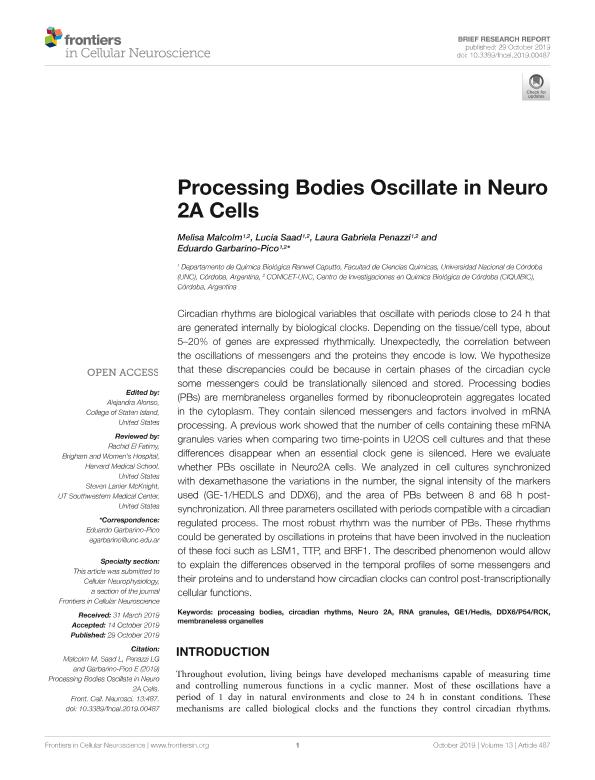Mostrar el registro sencillo del ítem
dc.contributor.author
Malcolm, Melisa

dc.contributor.author
Saad, Lucia Florencia

dc.contributor.author
Penazzi, Laura Gabriela
dc.contributor.author
Garbarino Pico, Eduardo

dc.date.available
2021-03-26T21:12:14Z
dc.date.issued
2019-10
dc.identifier.citation
Malcolm, Melisa; Saad, Lucia Florencia; Penazzi, Laura Gabriela; Garbarino Pico, Eduardo; Processing bodies oscillate in neuro 2A cells; Frontiers Media S.A.; Frontiers in Cellular Neuroscience; 13; 10-2019; 1-9
dc.identifier.uri
http://hdl.handle.net/11336/129080
dc.description.abstract
Circadian rhythms are biological variables that oscillate with periods close to 24 h that are generated internally by biological clocks. Depending on the tissue/cell type, about 5–20% of genes are expressed rhythmically. Unexpectedly, the correlation between the oscillations of messengers and the proteins they encode is low. We hypothesize that these discrepancies could be because in certain phases of the circadian cycle some messengers could be translationally silenced and stored. Processing bodies (PBs) are membraneless organelles formed by ribonucleoprotein aggregates located in the cytoplasm. They contain silenced messengers and factors involved in mRNA processing. A previous work showed that the number of cells containing these mRNA granules varies when comparing two time-points in U2OS cell cultures and that these differences disappear when an essential clock gene is silenced. Here we evaluate whether PBs oscillate in Neuro2A cells. We analyzed in cell cultures synchronized with dexamethasone the variations in the number, the signal intensity of the markers used (GE-1/HEDLS and DDX6), and the area of PBs between 8 and 68 h post-synchronization. All three parameters oscillated with periods compatible with a circadian regulated process. The most robust rhythm was the number of PBs. These rhythms could be generated by oscillations in proteins that have been involved in the nucleation of these foci such as LSM1, TTP, and BRF1. The described phenomenon would allow to explain the differences observed in the temporal profiles of some messengers and their proteins and to understand how circadian clocks can control post-transcriptionally cellular functions.
dc.format
application/pdf
dc.language.iso
eng
dc.publisher
Frontiers Media S.A.
dc.rights
info:eu-repo/semantics/openAccess
dc.rights.uri
https://creativecommons.org/licenses/by-nc-sa/2.5/ar/
dc.subject
CIRCADIAN RHYTHMS
dc.subject
DDX6/P54/RCK
dc.subject
GE1/HEDLS
dc.subject
MEMBRANELESS ORGANELLES
dc.subject
NEURO 2A
dc.subject
PROCESSING BODIES
dc.subject
RNA GRANULES
dc.subject.classification
Bioquímica y Biología Molecular

dc.subject.classification
Ciencias Biológicas

dc.subject.classification
CIENCIAS NATURALES Y EXACTAS

dc.title
Processing bodies oscillate in neuro 2A cells
dc.type
info:eu-repo/semantics/article
dc.type
info:ar-repo/semantics/artículo
dc.type
info:eu-repo/semantics/publishedVersion
dc.date.updated
2020-11-20T19:55:25Z
dc.identifier.eissn
1662-5102
dc.journal.volume
13
dc.journal.pagination
1-9
dc.journal.pais
Suiza

dc.journal.ciudad
Lausana
dc.description.fil
Fil: Malcolm, Melisa. Consejo Nacional de Investigaciones Científicas y Técnicas. Centro Científico Tecnológico Conicet - Córdoba. Centro de Investigaciones en Química Biológica de Córdoba. Universidad Nacional de Córdoba. Facultad de Ciencias Químicas. Centro de Investigaciones en Química Biológica de Córdoba; Argentina. Universidad Nacional de Córdoba. Facultad de Ciencias Químicas. Departamento de Química Biológica; Argentina
dc.description.fil
Fil: Saad, Lucia Florencia. Universidad Nacional de Córdoba. Facultad de Ciencias Químicas. Departamento de Química Biológica; Argentina. Consejo Nacional de Investigaciones Científicas y Técnicas. Centro Científico Tecnológico Conicet - Córdoba. Centro de Investigaciones y Transferencia de Villa María. Universidad Nacional de Villa María. Centro de Investigaciones y Transferencia de Villa María; Argentina
dc.description.fil
Fil: Penazzi, Laura Gabriela. Consejo Nacional de Investigaciones Científicas y Técnicas. Centro Científico Tecnológico Conicet - Córdoba. Centro de Investigaciones en Química Biológica de Córdoba. Universidad Nacional de Córdoba. Facultad de Ciencias Químicas. Centro de Investigaciones en Química Biológica de Córdoba; Argentina. Universidad Nacional de Córdoba. Facultad de Ciencias Químicas. Departamento de Química Biológica; Argentina
dc.description.fil
Fil: Garbarino Pico, Eduardo. Universidad Nacional de Córdoba. Facultad de Ciencias Químicas. Departamento de Química Biológica; Argentina. Consejo Nacional de Investigaciones Científicas y Técnicas. Centro Científico Tecnológico Conicet - Córdoba. Centro de Investigaciones en Química Biológica de Córdoba. Universidad Nacional de Córdoba. Facultad de Ciencias Químicas. Centro de Investigaciones en Química Biológica de Córdoba; Argentina
dc.journal.title
Frontiers in Cellular Neuroscience
dc.relation.alternativeid
info:eu-repo/semantics/altIdentifier/url/https://www.frontiersin.org/article/10.3389/fncel.2019.00487/full
dc.relation.alternativeid
info:eu-repo/semantics/altIdentifier/doi/http://dx.doi.org/10.3389/fncel.2019.00487
Archivos asociados
